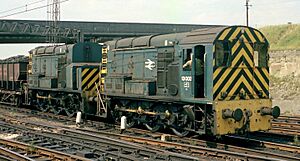British Rail Class 13 facts for kids
Quick facts for kids British Rail Class 13 |
|
 |
|
| 13001 at Tinsley TMD on 14 April 1984 | |
| Power type | Diesel-electric |
|---|---|
| Builder | British Railways’ Darlington Works (builder and rebuilder) |
| Build date | 1965 (rebuilt) |
| Total production | 3 |
| Configuration | 0-6-0+0-6-0 |
| UIC classification | C+C |
| Gauge | 4 ft 8 1⁄2 in (1,435 mm) |
| Wheel diameter | 4 ft 6 in (1.372 m) |
| Wheelbase | 42 ft 1+1⁄2 in (12.84 m) |
| Length | 60 ft 1 in (18.31 m) |
| Width | 8 ft 6 in (2.59 m) |
| Height | 12 ft 8+1⁄2 in (3.87 m) |
| Locomotive weight | 120 long tons (122 t) |
| Fuel capacity | 1,336 imp gal (6,070 L; 1,604 US gal) |
| Prime mover | English Electric 6KT, 2 off |
| Traction motors | EE, four off |
| Transmission | DC generators, DC traction motors, double reduction gearing |
| Multiple working | Not fitted (except control of slave by master) |
| Top speed | 20 mph (32 km/h) |
| Power output | Engine: 350 hp (261 kW) × 2 |
| Tractive effort | Maximum: 70,000 lbf (311.4 kN) |
| Train heating | None |
| Locomotive brakeforce | 37 long tons-force (370 kN) |
| Train brakes | Vacuum |
| Career | British Railways |
| Number | D4500–D4502, later 13001–13003 |
| Axle load class | RA 8 |
| Retired | 1983–1986 |
The British Rail Class 13 was a special type of train created in 1965. It was made by permanently joining two other trains, called Class 08 shunters. These unique trains were designed to help move railway wagons around a very busy place called the Tinsley Marshalling Yard.
A shunter is a small but powerful train used to move railway wagons short distances. A marshalling yard is a large area where trains are sorted and put together.
Contents
What Made the Class 13 Special?
The Class 13 was unusual because it wasn't built from scratch. Instead, it was created by taking two existing Class 08 shunter locomotives and linking them together forever. This setup was known as a 'master and slave' unit, or sometimes a 'cow and calf'.
How Did the Master and Slave System Work?
- Master Unit: One of the Class 08 trains was the 'master'. It kept its driver's cab and controlled both locomotives.
- Slave Unit: The second Class 08 train was the 'slave'. Its driver's cab was removed because it didn't need a driver. It was controlled by the master unit.
Both parts of the Class 13 were made heavier. This extra weight helped them grip the tracks better. This improved their ability to pull heavy loads.
Why Connect Two Trains?
At first, the two trains were connected cab-to-cab. But it was found to be easier to connect the master unit's front (nose) to the slave unit's cab end.
This dual-locomotive design was chosen for a good reason. The Tinsley Marshalling Yard had a special raised section called a 'hump'. A single, very long train might get stuck or scrape the ground when going over this hump. By using two shorter, connected trains, the Class 13 could handle the hump without any problems.
Where Did the Class 13 Work?
The Class 13 locomotives were specifically built for the Tinsley Marshalling Yard in England. This yard was a very important hub for sorting freight trains. The powerful Class 13s were perfect for pushing long lines of wagons over the hump.
When Were They Used?
The three Class 13 locomotives (numbered D4500–D4502, later 13001–13003) were used from 1965. They worked hard at Tinsley for many years. They were eventually retired from service between 1983 and 1986. None of these unique trains were saved.
Images for kids


